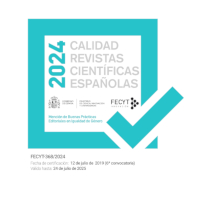A.S. Byatt y el “viajero perpetuo”: una práctica lectora de la nueva ficción británica
DOI:
https://doi.org/10.18172/jes.3450Palabras clave:
Ángeles e insectos, ficción histórica, novela, literatura británica, intertextualidadResumen
Aunque la mayoría de los lectores disfrutaron o por lo menos admiraron la novela “Possession”, escrita por A.S. Byatt, y merecedora del premio Booker, muchos se han quedado desconcertados por su obra de antes y después. Este artículo defiende que el problema no reside en las novelas en sí mismas, sino en la manera en que los lectores se acercan a las mismas. La lectura convencional que se suele llevar a cabo de la ficción postmoderna o experimental no le permite al lector entender y disfrutar de la obra densa y mareante de esta escritora. A través del análisis intertextual de su novela corta “Morpho Eugenia”, y en particular de dos textos imaginarios escritos por el protagonista, William Adamson, este artículo demuestra la manera en que la novela corta genera un tipo diferente de lectura. Siguiendo la metáfora de Byatt, en este artículo se recomienda que los lectores se conviertan en “viajeros perpetuos”, un modelo global de lectura que permitrá navegar no sólo por la obra de Byatt y el terreno de la ficción neo-victoriana, sino también por el campo de la nueva ficción británica y el populoso paisaje mediático en el que reside esta última.
Descargas
Citas
Adams, Ann Marie. 2003. “Dead Authors, Born Readers, and Defunct Critics: Investigating Ambiguous Critical Identities in A.S. Byatt’s Possession”. The Journal of the Midwest Modern Language Association 36 (1): 107-124.
Alfer, Alexa and Amy J. Edwards de Campos. 2010. A.S. Byatt: Critical Storytelling. Manchester: Manchester UP.
Barrell, John. 1992. “When will he suspect?” London Review of Books, 19 Nov. 1992, 18-19.
Barthes, Roland. 1971. Le Bruissement de la Langue. Paris: Éditions du Seuil.
Barthes, Roland. 2010. “From Work to Text”. The Norton Anthology of Theory and Criticism. Ed. Vincent B. Leitch. New York: W.W. Norton. 1326-1331. Trans. Stephen Heath.
Boccardi, Mariadele. 2009. The Contemporary British Historical Novel: Representation, Nation, Empire. New York: Palgrave Macmillan.
Byatt, A. S. 1992. Angels and Insects. New York: Vintage Books.
Byatt, A. S. 1992. Passions of the Mind: Selected Writings. New York: Turtle Bay Books.
Byatt, A. S. 2000. On Histories and Stories: Selected Essays. Cambridge: Harvard UP.
Darwin, Charles. “To Charles Lyell [10 December 1859]”. Darwin Correspondence Project, <https://www.darwinproject.ac.uk/letter/?docId=letters/DCP-LETT-2575. xml;query=higgledy-pigglety;brand=default>. (Accessed 25 Feb. 2016)
Dawson, Paul. 2015. The Return of the Omniscient Narrator: Authorship and Authority in Twenty-First Century Fiction. Columbus: Ohio State U.
Martin, Elaine. 2011. “Intertextuality: An Introduction”. The Comparatist, 35 (May), 148-151.
Fletcher, Judith. 1999. “The Odyssey Rewoven: A. S. Byatt’s Angels and Insects”. Classical and Modern Literature: A Quarterly 19 (3): 217-231.
Gitzen, Julian. 1995. “A. S. Byatt’s Self-Mirroring Art”. Critique 36 (2): 83-95.
Glendening, John. 2013. Science and Religion in Neo-Victorian Novels: Eye of the Ichthyosaur. New York: Routledge.
Hansson, Heidi. 1999. “The Double Voice of Metaphor: A. S. Byatt’s ‘Morpho Eugenia’”. Twentieth Century Literature 45 (4): 452-466.
Hennelly, Mark M., Jr. 2003. “‘Repeating Patterns’ and Textual Pleasures: Reading (in) A.S. Byatt’s Possession: A Romance”. Contemporary Literature 44 (3): 442-471.
Hicks, Elizabeth. 2011. “Public and Private Collections in A.S. Byatt’s The Children’s Book”. Mosaic 44 (2): 171-185.
Holmes, Frederick M. 1997. The Historical Imagination: Postmodernism and the Treatment of the Past in Contemporary British Fiction. Victoria: English Literary Studies.
Hutcheon, Linda. 1988. A Poetics of Postmodernism: History, Theory, Fiction. New York: Routledge.
Iser, Wolfgang. 2010. “Interaction between Text and Reader”. The Norton Anthology of Theory and Criticism. Edited by Vincent B. Leitch. New York: W.W. Norton. 1524-1532.
Jameson, Fredric. 1991. Postmodernism Or, The Cultural Logic of Late Capitalism. Durham: Duke UP.
Keen, Suzanne. 2006. “The Historical Turn in British Fiction”. A Concise Companion to Contemporary British Fiction. Ed. James F. English. Malden: Blackwell. 167-187.
Kristeva, Julia. 1986. “Word, Dialogue and Novel”. The Kristeva Reader. Ed. Toris Moi. Oxford: Blackwell. 34-61. Trans. Seán Hand.
Lackey, Michael. 2008. “A.S. Byatt’s ‘Morpho Eugenia’: Prolegomena to Any Future Theory”. College Literature 35 (1): 128-147.
Levenson, Michael. 2001. “Angels and Insects: Theory, Analogy, Metamorphosis”. Essays on the Fiction of A.S. Byatt: Imagining the Real. Eds. Alexa Alfer and Michael J. Noble. Westport: Greenwood Press. 161-174.
Machacek, Greg. 2007. “Allusion”. PMLA. 122 (2): 522-536.
Orr, Mary. 2003. Intertextuality: Debates and Contexts. Cambridge: Polity Press. 110
Poznar, Susan. 2004. “Tradition and ‘Experiment’ in Byatt’s ‘The Conjugial Angel’”. Critique 45 (2): 173-189.
Shuttleworth, Sally. 2001. “Writing Natural History: ‘Morpho Eugenia’”. Essays on the Fiction of A.S. Byatt: Imagining the Real. Eds. Alexa Alfer and Michael J. Noble. Westport: Greenwood Press. 147-160.
Thorne, Matt and Nicolas Blincoe, eds. 2001. All Hail the New Puritans. London: Fourth Estate, 2001.
Weinroth, Michelle. 2005. “‘Morpho Eugenia’ and the Fictions of Victorian Englishness: A.S. Byatt’s Postcolonial Critique”. English Studies in Canada 31 (2-3): 187-222.
Wood, James. 2002. “V.S. Pritchett and English Comedy”. On Modern British Fiction. Ed. Zachary Leader, Oxford: Oxford UP. 6-17.
Descargas
Publicado
Cómo citar
Número
Sección
Licencia
El autor o autora conserva todos los derechos sobre su artículo y cede a la revista el derecho de la primera publicación, no siendo necesaria la autorización de la revista para su difusión una vez publicado. Una vez publicada la versión del editor el autor está obligado a hacer referencia a ella en las versiones archivadas en los repositorios personales o institucionales.
El artículo se publicará con una licencia Creative Commons de Atribución, que permite a terceros utilizar lo publicado siempre que se mencione la autoría del trabajo y la primera publicación en esta revista.
Se recomienda a los autores/as el archivo de la versión de editor en repositorios institucionales.













